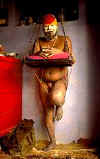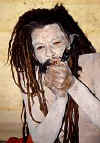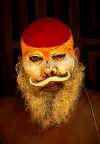|
|
||||
|
Role of
Internet In South Asian Development Technology
- a weapon to
Viewpoint Sundown Madness at Wagah Border
Heritage & Travel
Books
|
|
|
||
|
the-south-asian.com February 2001 |
||||
|
Page 2 of 3
Sadhus – Holy Men of India by Dolf Hartsuiker
Practices, Manners and Habits
For an ordinary human being these 'basic'
self-abnegations are already hard to comprehend. But
almost unimaginable are the extreme
self-mortifications by which a number of sadhus intend to speed
up their enlightenment. There are those who keep
their right arm straight up until it degenerates into
a kind of stick. Some do not sit and lay down for years on end, or keep
silence for many years, or wear a 'chastity-belt' forever, or fast for
a long time...
Most sadhus, however, worship Shiva - the God
Shiva is always minimally clad, which symbolizes his primal condition, his non-attachment to the world. With half-closed eyes he is immersed in meditation, in divine bliss. The Ganges springs from his long hair, his jata, as a fountain, splashing in the Himalayan mountains in the distance. The crescent -- the new moon, 'Shiva's moon' -- on his forehead, the cobra around his neck, the white bull Nandi, the river Ganges, and the full moon form a symbolic cluster which indicates Shiva's function as a fertility deity, a moon god. On his forehead are three horizontal lines, painted with ashes, representing the three main gods, the three 'worlds'. Around his neck is a garland of 108 beads, the 108 elements of material creation, and in his hand a rosary of 50 beads, the 50 letters of the Sanskrit alphabet. The two large rings through his ears are indicative of his extra-sensory perception. He is seated on a tiger skin, a symbol of power, showing his mastery over the animal world. In appearance sadhus try to resemble the gods, as they are known through ancient myths and popular legends, especially Shiva. Though Shiva is popularly known as the God of Destruction, for sadhus he is foremost the Master of Yogis. Quite a few sadhus walk about naked, symbolising their renunciation of the world of mortals, and rub their body with ashes of their holy fires, symbolic of death and rebirth. Many sadhus wear extremely long hair (jata), again in emulation of Lord Shiva, whose long strands of hair are regarded as the 'seat' of his supernatural powers.
Other deities besides Shiva are worshipped too, such as Rama or Krishna, who are both incarnations of Vishnu, a god who rivals with Shiva for the supreme position in the Hindu pantheon. Or one of the many goddesses, like Kali or Durga. The allegiance of sadhus can be recognised by differences in the marks on their forehead, and the colour of their clothes. In the past, there have been intense rivalries between the various sects, even leading to battle. But in essence all sadhus have the same roots.
|
||||
| Copyright © 2000 [the-south-asian.com]. Intellectual Property. All rights reserved. | ||||
| Home |


